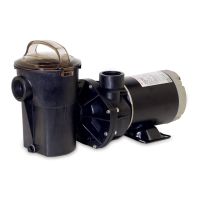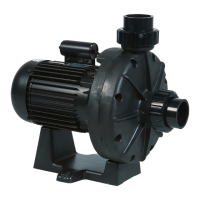Do you have a question about the Hayward SwimPro SWP120551 and is the answer not in the manual?
Adhere to electrical safety standards and qualified installation for hazard prevention.
Ensure proper use, supervision, and maintenance to prevent injury and ensure longevity.
Understand the pump's thermal protection and lack of SVRS for safe operation.
Position pump to minimize suction losses and comply with AS/NZS 3000 Wiring Rules.
Ensure a ventilated, dry, and well-drained area for motor cooling and longevity.
Install pump for easy visibility and accessibility of the plug and wall socket.
Securely mount pump to a base using lag screws and lock washers for stability.
Ensure power supply voltage and cable capacity match pump requirements per AS/NZS 3000.
All power outlet changes or installations must be performed by a qualified electrician.
Power must be supplied via an isolating transformer or an RCD with a 30mA residual operating current.
Single-phase motors have thermal protection that automatically shuts off and restarts the motor.
Fill strainer housing with water before operation; never run pump dry.
Open all suction, discharge, and air bleed valves for proper priming.
Turn on power and allow sufficient time for the pump to prime.
Regularly clean strainer basket and inspect/replace cover gasket as needed.
Motor bearings and shaft seals are self-lubricating; no additional lubrication is required.
Keep the motor clean and ensure air vents are unobstructed for cooling.
Replace shaft seals if they become damaged or worn over time.
All repairs, servicing, and maintenance should be done by authorized personnel.
Drain the pump and store it in a dry, well-ventilated room, protecting it from elements.
Check power cord, switches, breakers, fuses, and manual shaft rotation.
Investigate power cord, voltage, binding, overload, and thermal protection.
Check for open capacitor or debris in the impeller.
Ensure strainer is filled, gasket seated, valves open, and water level is adequate.
Test for vacuum development to diagnose suction line or strainer issues.
Check suction line, strainer, and piping for blockages or air leaks.
Address clogged strainers, undersized piping, plugged discharge, air leaks, or low voltage.
Investigate air leaks, cavitation, vibration, foreign matter, or worn bearings.
Adhere to electrical safety standards and qualified installation for hazard prevention.
Ensure proper use, supervision, and maintenance to prevent injury and ensure longevity.
Understand the pump's thermal protection and lack of SVRS for safe operation.
Position pump to minimize suction losses and comply with AS/NZS 3000 Wiring Rules.
Ensure a ventilated, dry, and well-drained area for motor cooling and longevity.
Install pump for easy visibility and accessibility of the plug and wall socket.
Securely mount pump to a base using lag screws and lock washers for stability.
Ensure power supply voltage and cable capacity match pump requirements per AS/NZS 3000.
All power outlet changes or installations must be performed by a qualified electrician.
Power must be supplied via an isolating transformer or an RCD with a 30mA residual operating current.
Single-phase motors have thermal protection that automatically shuts off and restarts the motor.
Fill strainer housing with water before operation; never run pump dry.
Open all suction, discharge, and air bleed valves for proper priming.
Turn on power and allow sufficient time for the pump to prime.
Regularly clean strainer basket and inspect/replace cover gasket as needed.
Motor bearings and shaft seals are self-lubricating; no additional lubrication is required.
Keep the motor clean and ensure air vents are unobstructed for cooling.
Replace shaft seals if they become damaged or worn over time.
All repairs, servicing, and maintenance should be done by authorized personnel.
Drain the pump and store it in a dry, well-ventilated room, protecting it from elements.
Check power cord, switches, breakers, fuses, and manual shaft rotation.
Investigate power cord, voltage, binding, overload, and thermal protection.
Check for open capacitor or debris in the impeller.
Ensure strainer is filled, gasket seated, valves open, and water level is adequate.
Test for vacuum development to diagnose suction line or strainer issues.
Check suction line, strainer, and piping for blockages or air leaks.
Address clogged strainers, undersized piping, plugged discharge, air leaks, or low voltage.
Investigate air leaks, cavitation, vibration, foreign matter, or worn bearings.
| Brand | Hayward |
|---|---|
| Model | SwimPro SWP120551 |
| Category | Water Pump |
| Language | English |











